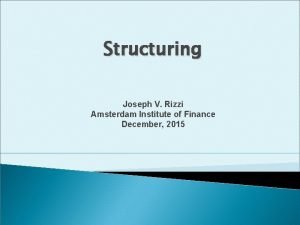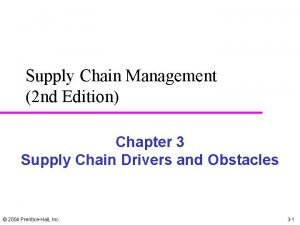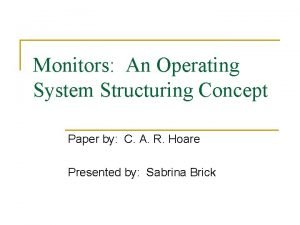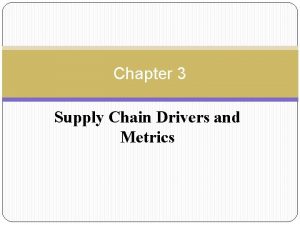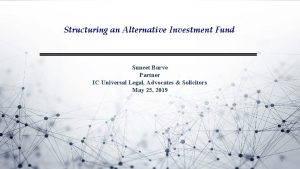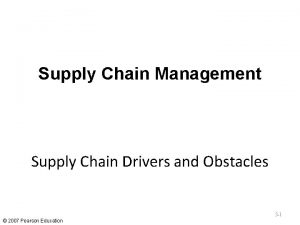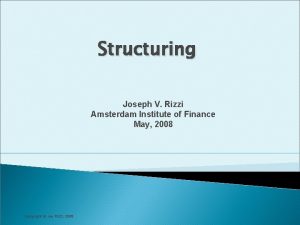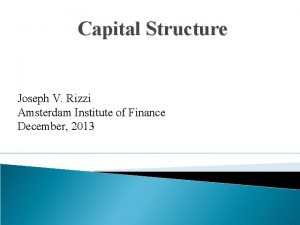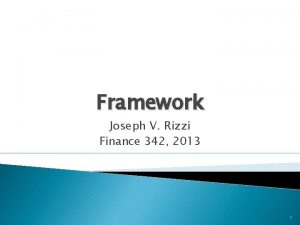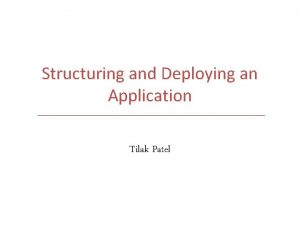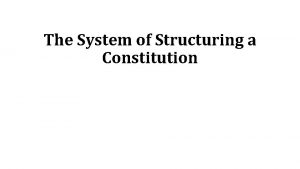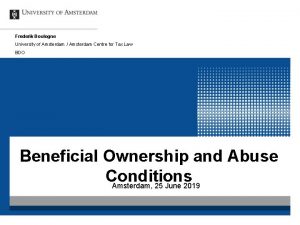Structuring Joseph V Rizzi Amsterdam Institute of Finance

























- Slides: 25

Structuring Joseph V. Rizzi Amsterdam Institute of Finance December, 2013 Copyright © Joe Rizzi, 2013

Transaction Framework Strategic Issues • Do I make the acquisition? Valuation • How much do I pay? Tactics • How do I make the offer? Financing • How do I pay? Integration • Implementation of acquisition Amsterdam Institute of Finance December, 2013 2

Transaction and Structuring Overview Creditors Rights Regulatory and Antitrust Contract Structuring Environment Business Plan Market Conditions Deal Accounting Transaction Characteristics Securities Financial Preferences Corporate Law Tax Competing Bidders Amsterdam Institute of Finance December, 2013 3

Structuring Environment Business Considerations: • Strategic Plans • Growth Plans • Management • Business Risk (Cash Flow Volatility) Financial Preferences: • Dilution • Control • Risk Tolerance • Flexibility • Exit Needs What do you want? Amsterdam Institute of Finance December, 2013 Deal • Maturity • Amortization • Seniority • Security • Covenants • Prepayment • Cost • Liquidity • Size How to get what you need! Financial Characteristics: • Sources and Uses • Operating Cash Flows • Leverage • Liquidity • Seasonality • Timing Market Conditions: • Depth • Pricing Requirements • Structural Needs • Cycle • Liquidity What can you get? 4

Different Menus As the credit curve shifts, the menu that is available to Issuers / Arrangers changes Bull Market Menu • Holding Company PIK • Tranche Term Loans • Covenant Light • High Yield Debt • Bridge Loans • Second Lien • Hybrid Preferred • Cross Lien Facilities • Asset Carve-outs • OPCO/PROPCO • Recapitalizations Bear Market Menu • Stretch Senior • Seller Notes • Senior Notes • Private Placements • Equity • R/C Lite • Mezzanine • Smaller Investor Friendly Issuer Friendly Amsterdam Institute of Finance December, 2013 5

Financing Approaches Left Hand Side Financing Based on the cash flow of a specific asset pool. Some examples include: • Asset Based Lending • Factoring • Leasing • Project Finance • Securitization Amsterdam Institute of Finance December, 2013 Right Hand Side Financing Based on the cash flow of the entire company. Some examples include: • Bank Debt • Public Bonds • Mezzanine • Preferred Stock • Common Stock 6

Critical Path & Decision Framework Bank Financing Credit Rating Determine Capital Structure Acquisition Bridge Takedown Hedge No Action Financial Flexibility Floating. Rate Target Credit Rating Advisory / Origination Amsterdam Institute of Finance December, 2013 Asset Carveout Securitization Prop Co Fixed- Refinance Bridge Bank Funding Rate Fixed Income Equity / Near Equity Underwriting Product Execution 7

Mechanics Purchase/Sale • Nondisclosure Agreement • Offering Memorandum • Data Room • Letter of Intent • Sale and Purchase Agreement Financing • Commitment Letter • Term Sheet • Credit Agreements • Intercreditor Agreements Amsterdam Institute of Finance December, 2013 8

Legal issues Involved in Financing the Transaction Commitment Letters Mac Due Diligence Syndication Flex Marketing Periods Fraudulent transfers Loan Documentation Intercreditor Covenants Amsterdam Institute of Finance December, 2013 9

Creating the Capital Structure Rule of Thumb Measures ◦ Balance Sheet Model ◦ Cash Flow Model Detailed Model ◦ Matching markets to the need ◦ Reverse inquiry ◦ Projections (amortization capability) Amsterdam Institute of Finance December, 2013 10

Deal Financial Arithmetic Amsterdam Institute of Finance December, 2013 11

Financing Need As a Starting Point Purchase Price ◦ Minimum/Maximum ◦ Recapitalization Dividend Debt Refinancing ◦ Callability ◦ Premiums ◦ Tax Issues Expenses Other Uses Amsterdam Institute of Finance December, 2013 12

Structuring Framework Senior Secured First Lien Revolver o o Tied to advance against current assets Crossing liens o o Macro: Ratio of 3 -4 x EBITDA Micro: Amortization analysis tied to cash flow in years 1 -7 o Senior debt ratio less Term Loan A amortization Term Loan A Term Loan B Second Lien o Macro: 0. 5 -1 x EBITDA o Limited amortization o Longer term o Can also be covenant lite Senior/Subordinated Unsecured Other Debt o Total Debt/EBITDA less Senior Debt/EBITDA Equity o Funding need less Total Debt/EBITDA Amsterdam Institute of Finance December, 2013 13

Sizing the Revolver Current Asset approach ◦ Use standard advance rates Accounts Receivable Inventory PP&E 80% 60% 40% ◦ Consider the following factors Seasonal Needs Future Working Capital Growth Unexpected Liquidity Needs Amsterdam Institute of Finance December, 2013 14

Sizing the Term Loans = Maximum Senior Debt - Revolver Focus is on Free Operating Cash Flow Market conditions also dictate the maximum tenor of the loan and the amount required to be amortized in the first five years Acceptable asset coverage is also a consideration in determining the size of the term loans Amsterdam Institute of Finance December, 2013 15

Add-On Term Loans Typical bank financings as structured as follows: Revolving Credit Term Loan A (amortising) Term Loans B & C (bullet/balloon) Large unfunded revolvers are seldom used today due to the fact that it is capital unfriendly to banks and companies don’t like to pay for unused commitments. In the interest of keeping flexibility for the long term, additional indebtedness baskets should be negotiated upfront. This allows companies to access either the bank or bond markets under their existing credit agreements and saves the costs of having to refinance. Amsterdam Institute of Finance December, 2013 16

Junior Capital Long Term Debt = Max Total Debt - Max Senior Secured Debt ◦ Senior unsecured ◦ Sub Debt Equity: ◦ Equity = Total Uses - Max Total Debt ◦ Common ◦ Hybrids Amsterdam Institute of Finance December, 2013 17

Subordination Senior lenders are concerned with the implications of having high yield investors at the table during a restructuring. EURO High Yield investors to date have not been as vocal as senior bank lenders, viewing the issue as one of pricing rather than principle. All other things being equal, sophisticated investors will probably price structural subordination at 60 -120 bps. Amsterdam Institute of Finance December, 2013 18

Contractual Subordination High Yield Bonds Holding Company 100% Equity Interest s ue Issues Intermediate Holding Company Operating Company Amsterdam Institute of Finance December, 2013 Operating Company Subordination Agreement Senior Secured Loan Operating Company 19

Structural Subordination Issues Holding Company High Yield Bonds 100% Equity Interest Issues Intermediate Holding Company Senior Secured Loan Support Package Operating Company Amsterdam Institute of Finance December, 2013 Operating Company 20

Structuring Perspectives Business Legal Entity Basis Bankruptcy Payment Priorities Provisions Reps/Warranties: What are the facts? Operating Covenants: Stop digging Financial Covenants: Preserve deal Remedy Structures to reduce credit risk Guarantees Pledges of Stock Subordination Amsterdam Institute of Finance December, 2013 21

Structuring Covenants – Preserving the deal or – I love you just the way you are! Ø Ø Ø There are no standard covenants. They must be tailored to fit each deal and loan structure. The steps in structuring the covenants are: o Identify the risks (business, financial and structural) o Select Covenants to monitor the risks • Need to prioritize the risks to monitor because it will be impossible to monitor every risk • The time and cost to monitor the covenants must be considered (i. e. , sometimes one covenant can cover multiple risks) o Set Appropriate Levels • Want the covenants to trigger a warning before any principal or interest payments become delinquent. Need to factor in any seasonal needs to the covenant levels. Amsterdam Institute of Finance December, 2013 22

Average Number of Covenants Per Euro Buyouts 2013 ( 9 mo) 2. 9 2006 3. 9 2011 3. 7 2004 4. 1 2012 2010 2009 2008 2007 3. 6 3. 7 3. 5 2003 2002 2001 2000 4. 2 4. 3 4. 2 Major Covenants (financial maintenance) – Industry Variation CAPEX Debt Service Fixed Charge Funded Debt Reason for Decline Institutional Loan Investors High Yield Market Competition Amsterdam Institute of Finance December, 2013 23

Issuer Objectives / Impact (1) Issue Impact Disclosure Public issues require disclosure of sensitive information Ratings impact of financing over existing debt Timing Urgency favors private relationship sources (e. g. Banks) Covenants Impact operating flexibility Seniority Impacts intercreditor issues Security Consider impact on other creditors (incl. suppliers) Currency Match with assets Maturity Long-term versus short-term mix Amsterdam Institute of Finance December, 2013 24

Issuer Objectives / Impact (2) Issue Impact Amortization Affects duration of debt Callability Flexibility Obligor Raises intercreditor issues Accounting On- or Off-balance sheet Tax Implications Instrument and location of interest tax shield Diversification Investor appetite Fixed / Floating Interest Rate Risk (IRR) Liquidity Default Risk Amsterdam Institute of Finance December, 2013 25
 Amsterdam institute of finance
Amsterdam institute of finance Amsterdam institute of finance
Amsterdam institute of finance Kelly rizzi
Kelly rizzi Charles university master of economics and finance
Charles university master of economics and finance Framework for structuring drivers
Framework for structuring drivers Time structuring in transactional analysis
Time structuring in transactional analysis Smart structuring
Smart structuring Islamic structuring
Islamic structuring Reverse triangular merger
Reverse triangular merger Structuring arguments
Structuring arguments Structuring element dapat berukuran
Structuring element dapat berukuran Wide vs narrow span of control
Wide vs narrow span of control Monitors in os
Monitors in os Supply chain drivers definition
Supply chain drivers definition Political risk structuring solutions
Political risk structuring solutions Stages of counselling process
Stages of counselling process Direct observation
Direct observation Structuring
Structuring Morphology
Morphology Dominance structuring example
Dominance structuring example Suneet barve
Suneet barve Time structuring in transactional analysis
Time structuring in transactional analysis Structuring element dapat berukuran
Structuring element dapat berukuran Structuring organizations for today's challenges
Structuring organizations for today's challenges Tax-efficient structuring
Tax-efficient structuring Drivers of supply chain management
Drivers of supply chain management
